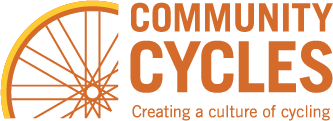Benefits of a 4:3 conversion
Building bicycle lanes with physical barriers to protect cyclists from fast moving cars is an increasingly standard solution to our unsafe roads. Also becoming standard is reconfiguration of four-lane roads into three-lanes, where there are two travel lanes and one center turning lane. This increases safety by eliminating lane-change-jockying and allowing construction of safer crossings for pedestrians. It also significantly improves access for first responders, who can use the center lane to get around cars.Rebalancing creates safety for all users
On four lane roads drivers often jockey for position, trying to be in the faster lane. Or they get stuck behind someone who is trying to turn left and then try to move into the outer lane, which is often a risky move. On a three-lane road, with just one travel lane in each direction, speeds are much more even and consistent, so drivers can more easily calculate when it is safe to turn left across oncoming traffic. Drivers are more likely to see cyclists in the bike lane and pedestrians on the sidewalk. The center turning lane also helps to prevent rear-end crashes. Mid-block, flashing-light crosswalks work better with three lanes than with four.
For all of these reasons, options like A & B typically result in reduction in crashes of 19 to 47%, according to the National Highway Safety Administration.
If the stretch was 20 miles long, the slower speed of two lanes might be unacceptable to most people. But Iris Avenue is just 1.2 miles long and we will still travel it in under five minutes.
Maintaining four lanes plus adequate bike lanes is very expensive & won’t happen anytime soon
Options C & D would:
- Require demolishing the existing curb and building new ones further out;
- Require additional pavement and sub-base work;
- Require moving the storm drainage sewer;
- Require moving the street lights;
- Require removal of some mature trees;
- Require the acquisition of some private property through purchase or condemnation because the right-of-way is not wide enough in some places.
Based on analysis of other road projects in Boulder, options A and B might be expected to cost about $5 million dollars (based on the Baseline project) and could be completed in two or three years. In contrast, Options C and D would cost $20 million dollars or more and the project would take roughly 20 years.
Adding protected intersections makes options A & B even safer
Options A & B have sufficient room for installation of robust protected intersections, something not possible with options C & D. Protected intersections make cyclists and pedestrians more visible at signalized crossings by (1) repositioning these vulnerable road users into a space where they can be more easily seen, and (2) slowing the speeds at which cars make turns through the intersection. This design feature is well explained here.
Center turn lanes create left-turn convenience
In a three-lane configuration, the center turn lane allows left-turning drivers to pull out of the main travel lanes and wait for a gap in traffic before turning without fear of being rear-ended. The same is true for drivers on side streets who need to turn onto the main road: They need to wait for a gap in only the closer lane, and then can turn into the center lane and wait for a gap in the outer lane before entering the flow of traffic.
Resources
Report a Maintenance Problem, City of Boulder
City of Boulder: To report a street maintenance related problem (potholes on the bike path, paths blocked by snow), complete the form and provide your contact information.
Report County Road Service Issue
Boulder County: To report a street maintenance related problem (potholes on the bike path, paths blocked by snow), complete the form and provide your contact information.
Report an Aggressive Driver
If you find yourself in a situation with an aggressive driver, remember you can dial *CSP (*277), free of charge. Report “real time” aggressive driving behavior to the Colorado State Patrol.
Report a Close Call – Inquire Boulder
Have you had a close call with a bicycle, pedestrian or motorist? This data is important and used in analysis of the safety of our streets.
Bike Theft Prevention & Registration
Learn tips and tricks for preventing your bicycle from being stolen, like registering your bike on Bike Index and knowing which lock to use how to properly use it.
Join the Advocacy Committee
We aspire to help Boulder become a dynamic and sustainable city that maximizes the safety, comfort, and convenience of its residents and prioritizes long-term environmental stewardship.
